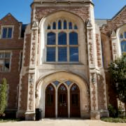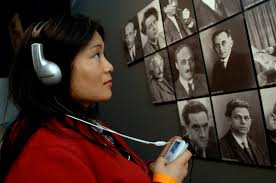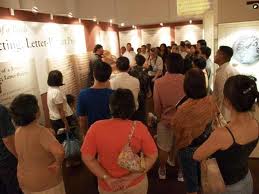 |
Title VI of the Civil Rights Act of 1964 (Race, Color, National Origin) and Executive Order 13166 (Limited English Proficiency)
 » Background
The Civil Rights Act of 1964, signed into law by President Lyndon Johnson on July 2 of that year, was the most sweeping civil rights legislation the Nation had seen to that date. Title VI of the Act  is intended to prohibit discrimination based on race, color, or national origin in programs and activities receiving FFA. is intended to prohibit discrimination based on race, color, or national origin in programs and activities receiving FFA.
▸ Read more...
Indeed, the purpose behind Title VI was simple: Federal dollars should not be used to fund or subsidize discrimination. In the five decades since passage of the law, Title VI has done much to better ensure access and opportunity in a host of important areas, including education, health care, and transportation.
At NASA, we have primarily focused our Title VI efforts in an area reflective of the Agency's space exploration, scientific, and education missions, that is, NASA-funded cultural institutions serving the public, such as museums, planetariums, and science centers.
» Compliance Requirements
» Promising Practices
Compliance Requirements
Under the NASA Title VI implementing regulations  , recipients of NASA FFA have the responsibilities to sign an assurance that the program will be conducted in compliance with all Title VI requirements, to maintain compliance records in such form as NASA determines is needed to assess compliance and to provide access to compliance information upon request. , recipients of NASA FFA have the responsibilities to sign an assurance that the program will be conducted in compliance with all Title VI requirements, to maintain compliance records in such form as NASA determines is needed to assess compliance and to provide access to compliance information upon request.
▸ Read more...
Recipients also have the responsibility to ensure meaningful access to their programs and activities for persons with limited English proficiency (LEP). This responsibility derives in part from the Title VI regulatory prohibition against recipients utilizing methods of administration which have the effect of subjecting individuals to discrimination because of their national origin, or have the effect of defeating or substantially impairing accomplishment of the objectives of the program as respects individuals of a particular national origin.
The regulations further state that a recipient, where it determines that the services and benefits of the program or activity it administers may not in fact be equally available to some racial or nationality groups, may properly give special consideration to race, color, or national origin to make the benefits of its program more widely available to such groups, not then being adequately served.
In addition, Executive Order 13166  , Improving Access to Services for Persons with Limited English Proficiency (August 11, 2000), directed each Federal agency that extends assistance subject to the requirements of Title VI, to clarify Agency recipients' obligations regarding LEP, consistent with the compliance standards and framework detailed in the U.S. (DOJ), Guidance to Federal Financial Assistance Recipients Regarding Title VI Prohibition Against National Origin Discrimination Affecting Limited English Proficient Persons (67 Fed. Reg. 41455) (June 18, 2002). , Improving Access to Services for Persons with Limited English Proficiency (August 11, 2000), directed each Federal agency that extends assistance subject to the requirements of Title VI, to clarify Agency recipients' obligations regarding LEP, consistent with the compliance standards and framework detailed in the U.S. (DOJ), Guidance to Federal Financial Assistance Recipients Regarding Title VI Prohibition Against National Origin Discrimination Affecting Limited English Proficient Persons (67 Fed. Reg. 41455) (June 18, 2002).
Assurances
NASA's Title VI regulations require that every application for Agency financial assistance contain an assurance that the program will be conducted or the facility operated in compliance with all requirements imposed by Title VI and obligates the recipient for the period during which the assistance is being provided. Assurances for research, training, or educational programs, which involve participation by students, fellows or trainees, extend to admission practices and to all other practices relating to the treatment of students or other participants.
Access to Compliance Information
 The NASA Title VI regulations require recipients to maintain compliance records in such form and containing such information as to allow the NASA Principal Compliance Officer to ascertain whether the recipient has complied or is complying with the NASA Title VI regulations. They also require that recipients provide access to sources of information as may be pertinent to ascertain compliance.
Program Administration
In evaluating grant recipient compliance with the Title VI regulations, NASA looks to provisions showing "illustrative applications" of discriminatory prohibitions. Among the more important illustrative applications that inform NASA's compliance analysis are the following:
- "In a research or training grant to a university for activities to be conducted in a graduate school, discrimination in the admission and treatment of students in the graduate school is prohibited . . ."
- "In a research or training grant, discrimination is prohibited with respect to the availability of any educational activity and any provision of medical or other services and any financial aid to individuals incident to the grant."
▸ Read more...
The NASA Title VI regulations also prohibit a recipient from utilizing methods of administration which have the effect of subjecting individuals to discrimination because of their race, color, or national origin, or have the effect of defeating or substantially impairing accomplishment of the objectives of the program as respect to individuals of a particular race, color, or national origin.
Using the illustrative applications and the provision on methods of administration, NASA seeks to determine whether grant recipients are in conformity with the equal opportunity requirements of the regulations, specifically with regard to institutional and program methods of administration, including a range of policies, procedures, and practices affecting students discussed below.
Determining the Extent of Obligation to Provide Limited English Proficiency (LEP) Services
NASA published its Title VI limited English proficiency (LEP) Guidance to Grant Recipients in December 2003. Consistent with Department of Justice's LEP compliance standards and framework, the NASA LEP Guidance to recipients clarified the responsibilities of institutions and/or entities that receive FFA from NASA, assisting them to fulfill their responsibilities to LEP persons pursuant to Title VI of the Civil Rights Act of 1964.
▸ Read more...
The NASA policy guidance emphasized that in order to avoid discrimination against LEP persons on the grounds of national origin, recipients of NASA FFA must take adequate steps to ensure that people who are not proficient in English can effectively participate in and benefit from the recipient's programs and activities. Therefore, consistent with the guidance, LEP persons should expect to receive the language assistance necessary to afford them meaningful access to the recipients' programs and activities, free of charge.
Under the NASA Title VI LEP Guidance, appropriate efforts to determine the extent of the obligation to provide LEP services require each recipient to develop an analysis based on the Four Factors, which include:
- The number or proportion of LEP persons eligible to be served or likely to be encountered by the program or recipient and
- The frequency with which LEP individuals come in contact with the program
- The nature and importance of the program, activity, or service provided by the program to people's lives
- The resources available to the recipient/recipient and costs
The intent of the NASA Title VI LEP Guidance regarding the Four Factors is to suggest a balance that ensures meaningful access by LEP persons to critical services while not imposing undue burdens on small business, small local governments, or small nonprofits. After applying the Four Factor Analysis, a recipient may conclude that different language assistance measures are sufficient for the different types of programs or activities in which it engages. Under NASA's Title VI LEP Guidance, the more important the activity, information, service, or program, or the greater the possible consequences of the contact to the LEP individuals, the more likely language services are needed. A recipient needs to determine the implications of denial or delay of access, e.g., life-threatening, to services or information for the LEP individual. Indeed, perhaps the most important kind of program or service referred to in the NASA Title VI LEP Guidance is that which is "life-threatening." While the nature of NASA programs and services receiving FFA, such as science centers, is normally not life-threatening, these recipients' programs may be said to be life-enhancing or enriching, and as such have unique importance to those seeking to experience them.
Establishing an Effective Language Access Plan
After completing the Four Factor Analysis and deciding what language assistance services are appropriate, a recipient should develop an implementation plan to address the identified needs of the limited English proficient (LEP) populations they serve.
▸ Read more...
The development and maintenance of a periodically-updated written Language Access Plan (LAP) for LEP persons for use by recipient employees serving the public will likely be the most appropriate and cost-effective means of documenting compliance and providing a framework for the provision of timely and reasonable language assistance.
Further, a written LAP provides the basis for fully leveraging the Four Factor Analysis to provide meaningful access to programs and services for LEP individuals. This means undertaking a number of practical, "real-world" steps, including, but not limited to, helping employees to identify the language(s) of the LEP persons they encounter; providing appropriate language assistance measures and training of staff, e.g., how to respond to LEP individuals who have in-person contact with staff; and providing notice to LEP persons of language services available.
Two recent LEP guidance documents from the DOJ, "Language Access Assessment and Planning Tool for Federally Conducted and Federally Assisted Programs  " (May 2011) and "Common Language Access Questions, Technical Assistance and Guidance for Federally Conducted and Federally Assisted Programs " (May 2011) and "Common Language Access Questions, Technical Assistance and Guidance for Federally Conducted and Federally Assisted Programs  " (August 2011), provide in-depth information to Federal agencies and their grant recipients on developing and implementing LAPs consistent with LEP requirements. " (August 2011), provide in-depth information to Federal agencies and their grant recipients on developing and implementing LAPs consistent with LEP requirements.
These new guidance documents build on the original "Four Factor" analysis by identifying the components parts of an effective LAP. These include:
- Identification of persons who will implement the plan
- Identification and assessment of LEP communities
- Identification of funding and procurement issues
- Notice of language assistance services
- Staff training on policies and procedures
- Collaboration with LEP communities and other stakeholders
- Monitoring and updating of policies, plan and procedures
- Description of timeframe, objectives and benchmarks
Recipients should continue to carefully review DOJ's May and August 2011 LEP guidance documents to incorporate key Plan elements identified by DOJ not already explicit in the recipient's Plan. For example, DOJ guidance recommends that LEP Plans for recipients should "detail the chains of command for authority and oversight and explain any coextensive responsibility and coordination with other agencies, divisions, and offices." The guidance documents also provide further explanation and detail regarding, for example, the roles and responsibilities of an LEP coordinator, the establishment of a process for LEP individuals to provide feedback if they believe they are being denied services because of their lack of English proficiency, the development of multilingual Web sites, the purposes and utility of monitoring and updating LEP Plans, hiring and utilization of bilingual staff, and considerations for assessing current staff's ability to provide language assistance. These are just a few examples of the kinds of information provided in the guidance that recipients may wish to use to further enhance their LEP Plan.
Recipients should focus particularly on sections of the DOJ guidance documents dealing with translation of vital information and hiring, training, and utilization of bilingual staff. These areas bear close and continuing scrutiny by recipients. In addition, we recommend that recipients imbue their Plans with appropriate timeframes, objectives and benchmarks consistent with DOJ guidance.
Recipients should also obtain a copy of DOJ's video series  , Overcoming Language Barriers, designed as a training tool for management and language coordinators of Federal agencies and recipients seeking to improve their ability to provide meaningful access to LEP individuals.1 , Overcoming Language Barriers, designed as a training tool for management and language coordinators of Federal agencies and recipients seeking to improve their ability to provide meaningful access to LEP individuals.1
Promising Practices
 The promising practices cited in this section are culled from information collected during two NASA Title VI-LEP compliance reviews, one conducted on the Exploratorium Museum in San Francisco, California and the other on the American Museum of Natural History in New York City. As recipients providing public services in extremely diverse and highly populated metropolitan areas, both institutions encounter a large number of both English proficient and LEP visitors each day. Their policies and practices regarding LEP obligations therefore provide ideal case studies for recipients nationwide.
Determining the Extent of Obligation to Provide LEP Services
Written Four Factor Analysis Based on Utilization of Quantifiable Measures and Qualitative Assessment Data
The Exploratorium Museum  in San Francisco, California developed a written Four Factor Analysis that included an assessment of the number of LEP persons served or encountered in the Museum's eligible service population. The institution's analysis under Factors 1 and 2 included assessment based on quantifiable, reliable, and objective measurements such as a random sampling of visitors to the museum to allow the museum to determine with as much accuracy as possible the number of LEP persons, and the language backgrounds of those persons the museum is encountering on a daily basis. in San Francisco, California developed a written Four Factor Analysis that included an assessment of the number of LEP persons served or encountered in the Museum's eligible service population. The institution's analysis under Factors 1 and 2 included assessment based on quantifiable, reliable, and objective measurements such as a random sampling of visitors to the museum to allow the museum to determine with as much accuracy as possible the number of LEP persons, and the language backgrounds of those persons the museum is encountering on a daily basis.
▸ Read more...

Under Factor 3, the museum addressed the nature and importance of its programs and services through written discussion and analysis of the museum's exhibits and displays and an assessment as to which ones required additional efforts to ensure that LEP individuals have meaningful access to them. For this factor, the museum also included planned actions for how and when the museum would provide the needed adjustments and enhancements on an exhibit-by-exhibit basis to ensure such access.
This analysis also included language services to enhance visitor safety during visiting hours and in emergency situations. The Exploratorium carefully explored the most cost-effective means of delivering competent language services and accurate language services before limiting services due to resource concerns, recognizing that as a large entity serving a significant number or proportion of LEP persons, to the extent that the museum's Four Factor Analysis called for the museum to limit language assistance services, the museum should ensure that's its resource limitations are well-substantiated within its Four Factor Analysis.

The American Museum of Natural History  (AMNH) in New York City conducted a careful review and analysis of the demographics of metropolitan area in which it is located as well as the museum's own LEP encounters. The museum used quantifiable, reliable, and objective measurements to determine with as much accuracy as possible the number of LEP persons, and the language backgrounds of those persons the museum is encountering on a daily basis and who are coming into contact with its programs and services. Finally, the museum incorporated these factors into its LEP Plan. (AMNH) in New York City conducted a careful review and analysis of the demographics of metropolitan area in which it is located as well as the museum's own LEP encounters. The museum used quantifiable, reliable, and objective measurements to determine with as much accuracy as possible the number of LEP persons, and the language backgrounds of those persons the museum is encountering on a daily basis and who are coming into contact with its programs and services. Finally, the museum incorporated these factors into its LEP Plan.
The museum's LEP analyses have been data driven, which is important in conducting and revisiting analysis as to the languages spoken and frequency of encounters with LEP populations. AMNH utilized the following sources of information to identify the LEP populations with which it comes into contact, and the frequency of contact: zip code information from ticket services and school group visits, the U.S. Census, usage of the museum's Space Show audio translators, its Spanish Telephone Information Line, and utilization of it Language Button ("I Speak") Program, a voluntary program for museum employees that has been a great success, establishing that nearly 40 languages other than English are fluently spoken among the museum's own staff and volunteers.
Utilizing these tools, the museum has determined that the 10 most frequently spoken languages within which it comes into contact are Chinese, English, French, German, Italian, Japanese, Korean, Portuguese, Spanish, and Russian. The museum informs NASA that it intends to supplement these sources with visitor surveys of native languages and English language proficiency. Importantly, the results of the museum's analysis in regard to these two factors are fully reflected in its LEP Plan.
In considering Factor 3, AMNH appropriately took into account the ways in which denial or delay of services may negatively impact LEP individuals. For example, the museum has issued brochures with floor plans in 10 languages, including Spanish, Chinese, and Korean, among the most frequently spoken languages based on the museum's analysis under Factors 1 and 2. Consistent with NASA LEP Guidance, these brochures are available at key points of entry.2
In the exhibitions context, in light of LEP obligations, the museum's Exhibitions Department is consciously focusing on designing interactive exhibitions components that are as visually self-explanatory as possible, so as to minimize the need for written instructions. Other areas of the museum's operations, such as the food service areas, are also utilizing this approach.
Innovative and Cost-Effective Mechanisms for Improving LEP Access
In addition to providing readily accessible brochures with floor plans in 10 different languages, AMNH is doing a great deal around interactive pictorial components. Both Exploratorium in San Francisco and AMNH are increasingly utilizing interactive pictorial components for special temporary exhibitions used to facilitate visitors' understanding independent of language.
▸ Read more...
These design features provide pictures, sketches, and graphics to help meet the needs of LEP visitors as well as of young visitors who are not yet proficient readers. Another example: AMNH offers foreign language audio translations of its Hayden Planetarium Space Shows, providing translations in a variety of languages.
For its Journey to the Stars show, audio translations were made available in Chinese, French, German, Hindi, Italian, Japanese, and Spanish. DVD versions of the Space Shows offer foreign language options as well. AMNH reports that it uses a centralized translation service for its communications materials, such as brochures and "I speak" buttons. Another museum has requested funding to address needs regarding limited English proficiency (LEP) by way of a National Science Foundation Grant (Bridging the Language Barrier).
The Exploratorium Museum is investigating the use of two-dimensional bar coding and the use of a WEB interface to enhance language assistance service. The museum staff noted that the research in this area holds potential for improved communication that goes beyond translation of hard copy guidance and instruction and may provide a less intrusive and cost-effective way to improve communication with LEP persons. AMNH reports that it uses a centralized translation service for its communications materials, such as brochures and "I speak" buttons.
Establishing an Effective Language Access Plan
Utilization of NASA LEP Guidance
The Exploratorium Museum in San Francisco and AMNH in New York City carefully reviewed and fully utilized NASA's LEP Guidance for Grant Recipients (December 2003) in developing their LEP Plans. For example, AMNH undertook an analysis which included determining which written materials should be translated, utilizing the Guidance's "safe harbor."
 Further, AMNH established through its LEP Working Group and Coordinators a structure regularly assessing the needs of the populations most frequently encountered or affected by the program to determine which materials and information should be translated, giving consideration to providing such information electronically, e.g., on the museum's website, and through use of other media, e.g., brochures, posters, to broaden the museum's outreach efforts to LEP persons and communities.
Language Button/"I Speak" Program
The AMNH has established a vibrant Language Button/"I Speak" Program, with museum employees and volunteers displaying the languages other than English in which they are fluent, in order to better assist LEP patrons.
The museum reports that employees and volunteers take great pride in displaying their buttons and being able to offer this assistance. Thirty-six languages are currently represented. Also, the museum has determined that 26 of its current 110 Education Teaching Volunteers are fluent in one or more foreign languages. The Teaching Volunteers offer assistance to both LEP and non-LEP patrons by working specifically with students who visit the exhibition halls weekday mornings, giving brief focused tours; staffing carts with artifacts, specimens, and other touchable objects relating to the halls' content and concepts; and answering questions.
Enhancements to Public Safety Measures
The safety of the AMNH's visitors and how limited English proficiency (LEP) services can enhance personal safety is an important concern for the Museum. As a museum located in one of the most important metropolises in the U.S., the museum is fully aware of the potential for man-made, as well as natural, disasters to create an emergency situation for its staff and visitors.
To address this, the museum has taken several steps. It has employed Language Line, a telephone interpretation service that Visitor Services representatives, security guards, and other staff can assess quickly to address urgent issues with LEP visitors, such someone who has inadvertently been separated from his or her party. The service immediately connects the LEP visitor with a proficient native speaker who then communicates with the museum personnel.
Additionally, the museum utilizes strobe lights for emergency evacuation purposes and guards trained to use gestures and physical actions to alert all visitors in emergencies. The museum is currently developing the use of an emergency broadcast system in multiple languages.
Collaboration with LEP Communities and Other Stakeholders
American Museum of Natural History's LEP Working Group includes the heads of all relevant program heads for this area of its Plan, such as its Education, Communications, Event and Conference Services and Membership leads, all of whom are making important contributions to the implementation of the museum's Plan. The museum's efforts are fully reflective of and consistent with relevant guidance.
 For example, regarding outreach to LEP communities, the museum maintains long-standing relationships with over 350 New York-based foreign press and over 40 local, non-English speaking speaking newspapers. AMNH posts its activities and events on the weekly calendar of the Foreign Press center, which reaches over 1600 internal media contacts. In addition, the museum invites international media and local community newspaper outlets to all its events, including El Diario La Prensa (Spanish), Yonhap News Agency (Korean), Xinhua News Agency (Chinese) and Nippon TV (Japanese), and provides foreign language proficient staff experts and scientists at specific events.
Educational Partnerships and Educational Initiatives with Limited English Proficiency (LEP) Components
American Museum of Natural History (AMNH)'s education related activities incorporate limited English proficiency (LEP) components involve working closely with LEP stakeholders to realize increased access for language minorities to the museum's programs and services. For example, the museum's Global Weekend series are cultural programs offered to the public that regularly present a selected community and its culture from the museum's metropolitan area.
The museum also reaches out to LEP and bilingual audiences through its collaborating partners and over 50 community organizations, consulates, and cultural and academic centers that focus on communities reflecting a variety of national origins. Examples of languages featured in programs in the past year include Arabic, Hindi, Japanese, Kyrgyz, Mandarin, Quechua, Spanish, Tibetan, and Ukrainian. Whenever possible, at the program itself, the museum features a printed guide, speakers, and an evaluation in both English and the community's primary language.
▸ Read more...
AMNH was recently selected by the New York State Education Department to pilot a Master of Arts in Teaching program that will prepare 50 new Earth science teachers, grades 7-12, through coursework, museum residencies, and mentored residencies in host schools, to teach in high-needs urban schools. A key feature of this five-year pilot program will be preparing candidates for excellence in teaching English Language Learners or ELL (i.e., LEP students); and the museum has received funding from the National Science Foundation's (NSF) Robert Noyce Teacher Scholarship Program to support this effort. The NSF funding, which began in August 2011, will enable the museum to assess the ELL needs of participating New York City and area public schools and to provide ELL training and resources to museum education and science staff who will teach and mentor the teacher candidates.
AMNH, in collaboration with nine New York City public schools and with support from the National Oceanic and Atmospheric Administration (NOAA), offered a Science Literacy Program for science educators working with English language learners in 6th grade. The NOAA/the museum ELL initiative's five components— professional development, resources, guided field trips, access to bilingual educators and scientists, programs and memberships for families and administrators—were consistent in approach and flexible enough to be adapted in four different ELL contexts: dual language programs, bilingual programs, English immersion programs, and special education with differentiated instruction. The ELL-Earth Science Initiative  website also shares resources and ELL student learning experiences with teachers and the public. website also shares resources and ELL student learning experiences with teachers and the public.
AMNH's Urban Advantage Program, launched in 2004 by the museum in partnership with the NYC Department of Education and seven other NYC-based science-rich cultural institutions, offers access to the expertise and resources of the UA partner institutions, support for students from scientists and science educators, educational outreach to families, and capacity building.
UA currently serves more than 35,000 students in public schools with a population that is demographically similar to all NYC public schools, which includes 15% English Language Learners. To achieve the goal of engaging as many families as possible with UA science education resources, UA provides its Family Guides in 10 languages (English, Spanish, Arabic, Bengali, Chinese, Haitian Creole, Korean, Russian, Urdu, and French.) (See also, New York University Institute for Education and Social Policy (ISEP) Policy Brief, "Can Formal-Informal Collaborations Improve Science Literacy in Urban Middle Schools?" The Impact of Urban Advantage").
Enhancing Efforts to Make Web Content Limited English Proficiency (LEP) Accessible
NASA recommends that the museum look into alternative mechanisms for addressing issues of Web content accessibility. We recommend that the museum begin by reviewing the section of Department of Justice's August 2011 guidance, "Understanding when/how to make your website more accessible to limited English proficient (LEP) persons."3
This section of the guidance links to the "Top 10 Practices for MultiLingual Websites" which states: "Online communications must address the language preferences of users. The use of machine or automatic translations  is strongly discouraged even if a disclaimer is added. If government agencies decide to use software assisted translation, have the translation reviewed by a qualified language professional before posting it to the website to ensure that the translation correctly communicates the message."4 (Emphasis added.) Materials and information provided through guidance and various cites to which it is linked provide excellent resources for enhancing online content to better meet the language needs of LEP individuals reviewing the museum's Web site. is strongly discouraged even if a disclaimer is added. If government agencies decide to use software assisted translation, have the translation reviewed by a qualified language professional before posting it to the website to ensure that the translation correctly communicates the message."4 (Emphasis added.) Materials and information provided through guidance and various cites to which it is linked provide excellent resources for enhancing online content to better meet the language needs of LEP individuals reviewing the museum's Web site.
The key is to determine which Web content and exhibition related information on the museum's floor are vital, within the meaning of the relevant guidance, and then to provide translation that meets applicable quality standards accordingly.
Staff Recruitment and Involvement
The American Museum of Natural History's ethnically diverse workforce reflects the demographics of its local community. To build on that resource, the museum includes language preference requests in its Job Postings for positions that work with the public. In addition, the museum has instituted a Language Button Program ("I speak cards") with "I speak…" buttons worn by over 400 staff speaking more than 30 languages. Importantly, the museum conducts training for the staff wearing the buttons. Information booths are located at the main entry points to the museum and at ticket desks marked with the international symbol "i". They are usually staffed with persons wearing the "I speak…" buttons who can provide foreign language services.
Strategies for Engaging Underserved Groups: Partnering with the Specific Communities
The Exploratorium, a science center in San Francisco, California, is implementing an initiative to engage Latinos in the Bay Area, and finding success through a well-defined, strategic approach.
Using a combination of audience research and limited English proficiency (LEP) analysis (as required of grant recipients under Executive Order 13166), the Exploratorium found that the local Latino population had been underserved by the museum. With the support of leadership and participation from staff across the institution, the Exploratorium responded by identifying Latinos as a key audience for engagement, especially in light of the museum's move to a new, more centrally located site, in the spring of 2013.
▸ Read more...
For several years, the Exploratorium has conducted qualitative and quantitative market research to inform its interactions with the local Latino community. Those studies revealed that even though Latinos comprised 23% of the Bay Area's population in 2010, only 11% of visitors to the museum were Latinos. The goal of the Exploratorium's Latino Audience Engagement Initiative is to increase visitation of Latino communities so the institution's constituency matches surrounding community demographics.
In order to meet this goal, the Exploratorium established a two-pronged approach, working internally through staff development, and externally through increased community interaction. To guide the work, they contracted with a consultant specializing in Latino market research and community engagement. These efforts helped support the museum's working group to focus outreach efforts and better understand their Latino audiences.
The museum began by setting a goal for increasing Latino visitation to 26% by 2020. As part of their efforts to build internal capacity—particularly among front-line staff who communicate directly with museum visitors—they focused on recruiting and hiring bilingual and bicultural individuals. To this end, the Latino Audience Engagement group collaborated with the museum's Organizational Development division to target appropriate recruitment venues and identify qualified job applicants.
The plan also focused on engaging Latinos with programming that combined elements of both language and culture. Events included presentations in Spanish, and took advantage of the museum's science content and learner-centered philosophy. Their onsite events—just one example of this type of outreach—have become important in connecting the museum with Latino extended families. Engineering Day, for example, held annually in September, gives the Exploratorium the opportunity to partner with the Society for Hispanic Professional Engineers (SHPE) to provide volunteer Spanish interpretation for audience members.
The Exploratorium has also initiated a key relationship with Univision, a local Spanish-language television station. Through this partnership, a series of two-minute science segments  featuring museum staff is broadcast in Spanish as part of the station's early-morning Al Despertar show. Viewers of this local news show are beginning to see the museum as an accessible, relevant, family-friendly educational resource. featuring museum staff is broadcast in Spanish as part of the station's early-morning Al Despertar show. Viewers of this local news show are beginning to see the museum as an accessible, relevant, family-friendly educational resource.
As part of our their regular online programming, the Exploratorium has also recently produced and posted several Spanish-language shows on its own website, including an onsite webcast series featuring the landing of the Mars rover Curiosity  . .
Such long-term connections and event-based programs are a hallmark of the museum's strategy of strengthening communications with the Latino community, and point the way for future engagement. The Exploratorium is planning other regular programs and events for its new venue at Pier 15, located on the waterfront in downtown San Francisco, with easy access via public transportation.
Other efforts have focused on more long-term engagement. For example, the Exploratorium is having many of its exhibit labels professionally translated into both Spanish and Chinese (another significant language prevalent in the museum's service area). They have also embarked on a program of creating multilingual collateral and signage to assist with wayfinding and provide content information. Multilingual visitor information and science content is also being presented on both the museum's website and mobile website.
For several years, the Exploratorium has approached the need for offering access to multilingual science-content resources by creating websites in other languages, including a site on geologic research in Kamchatka in Russian  ; on the assessment of scientific evidence in Spanish ; on the assessment of scientific evidence in Spanish  ; and on the history and science of Polynesian navigation in Hawaiian ; and on the history and science of Polynesian navigation in Hawaiian  . .
Beyond simply translating information into Spanish, however, the Exploratorium continues to develop culturally appropriate programs and resources that highlight the fact that Latinos have a long and strong heritage of science, engineering, and mathematics. Museum staff involve Latino scientists and artists in museum events and programming and work diligently to find authentic connections that emerge from the cultural roots of science.
Thus, in the areas of astronomy, chemistry, and biology, among others, the Exploratorium taps cultural traditions to extend community connections. Programs have focused on the use of natural pigments in Oaxaca, revealing the chemistry of dyes; tracking seasons and keeping calendars using ancient Mesoamerican pyramids; examining the benefits of native plants and foods, and much more.
Ultimately, the Exploratorium's strategic approach of reaching out to Spanish-speaking individuals in their service area is based on a single notion: incorporating Latino culture and language into the everyday operations of the museum, both physically and virtually.
1 The video is comprised of three segments: (1) Creating language access policies, plans, and procedures – 25 minutes; (2) Approaches to ensuring the quality of language assistance services – 35 minutes; and, (3) One agency's experience implementing a language access program – 19 minutes. To receive copies of the video series, an accompanying summary document, or if to ask any follow-up questions, recipients may send an email request to DOJ's Federal Coordination and Compliance Section at LEP@usdoj.gov.
2 See NASA LEP Guidance, Sec. VII(4).
3 See Section W  . .
4 See http://www.howto.gov/web-content/multilingual/best-practices  . . |
 |








